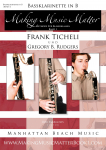Komponist:
Suzuki, Eiji Besetzung:
Blasorchester
Genre:
Transkriptionen The Merry Widow Waltz“Love Unspoken” from the operetta The Merry WidowThis is a revised edition of the original arrangement included as free music for the magazine Band Journal (December 2000). This song was not in my previous arrangement “Selections from The Merry Widow”. I intentionally avoided its triple meter. One reason is the challenge for school bands to correctly perform waltz time, but moreover, I felt the song did not suit the overall structure of that arrangement. Mr. Kawamoto, former chief editor of Band Journal, was quick to point this out. He suggested that I go ahead and arrange the missing waltz.This arrangement is in simple cantabile style. You can hear the “selections” orchestration. Also, a bit of trivia, perhaps unnecessary information, but the prelude melody has a secret. It is taken from "Da geh' ich zu Maxim" (I'm off to Chez Maxime – aria of Danilo) from the same operetta. The theme of "Da geh' ich zu Maxim" was ironically quoted by Shostakovich in the first movement of his Symphony No. 7. Minao Shibata suggest that perhaps the lyric in the chorus “goodbye my fatherland” depicts a hidden message by the composer since the symphony was written about war.I thought it would be interesting to consider the connection between Shostakovich and Lehar. This use of the theme is the result of it. We can only imagine the suffering Shostakovich endured and hope it will not be repeated by any of us.“ Sandmännchen”, VolkskinderliederThis is a revised edition of the original arrangement included as free music in the December 2001 edition of the magazine Band Journal.When hearing the name Brahms, one is quick to envision symphonies, concertos, chamber music, and piano and other instrumental music. However, Brahms has written a number of vocal works. “Volkskinderlieder” was written for solo voice and piano when he was 25 years of age. “Sandmännchen” is the 4th title in this collection created for mentor Robert Schumann’s children. This is one of the most beloved and often sung vocal pieces in a lullaby style.My original arrangement was for Flute and Orchestra (Fl: Shigenori Kudo, Cond: Shunsaku Tsutsumi) recorded on the CD “LULLABY” (Victor Entertainment) commemorating the Crown Princess of Japan Masako’s pregnancy. The original harmony was rearranged drastically in order to reflect an easy listening music style. When flute soloist Mr. Kudo heard the arrangement, he declared “Mantovani!” (laughing).In this band arrangement, the vocal part is written not as a solo but as an ensemble. From the 2nd measure of D , it may be performed by solo flute. Piano is an acceptable replacement for harp. I highly recommend including this part.
Folgende Optionen können gewählt werden um diese Ausgabe zu konfigurieren:



